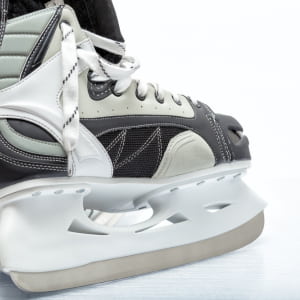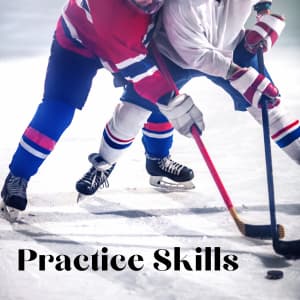How Much Does It Cost to Play Ice Hockey:
Demystifying Myths and Addressing the Realties of Hockey
“Isn’t Ice Hockey so expensive?!” We are going explore the myths and truths regarding how much does it cost to play Ice Hockey. We usually hear these questions, especially from all those non-hockey folks. Ice hockey is often perceived as an exceedingly expensive sport by those not involved in it. While it can be costly, that’s not always the case. Let’s delve into the matter and uncover ways to manage and control expenses in ice hockey.
- How Much Does It Cost to Play Ice Hockey:
- Demystifying Myths and Addressing the Realties of Hockey
- Ice Hockey Equipment Cost
- What about Buying New vs. Used Gear
- Why Ice Time is Essential and Expensive
- Practicing Those Skills on the Ice
- Team and League Fees
- Differentiating Between Recreational and Competitive League Fees
- Pay-to-Play Tournaments vs. Travel on Your Own
- Expenses Related to Transportation, Accommodation, and Meals
- Training Expenses
- Equipment Fees and Additional Costs
- Great Ways to Offset the Hockey Costs!
- Fight or Flight?
We know all about fueling our kids’ passion for Ice Hockey while keeping our finances in harmony. So, let’s dig through the financial facts and make sure our young champs can hit the ice with their hearts soaring and our wallets smiling! We will also examine the multi-dimensional world of Ice Hockey because it’s not just one tuition for all! There is a full spectrum of levels and leagues, and each comes with its own unique price tag. Let’s also take a look at the ways to save money, how to spot great value for your investment, and financial assistance!
We are going to break down where and how the expenses add up, from one of the most notoriously “expensive youth sports”. I may disagree and commit to comparing this to other sports.

Also, do not let the haters scare you away. Hockey is a wonderful sport with many gifts. And believe it or not, it does not really have to be as expensive as you may overhear. In fact, maybe there are ways to save! And let’s face it parents, there are plenty of other sports not far behind Hockey. With practically year-rounds of many sports, add-on the exercise trainers, sports trainers sport specific, skills clinics, camps, travel tournaments, and gear – many sports are catching up to us.

Yes, I said it..maybe it is not one of the most expensive sports…but the way the sport is played, or the level of play your kiddo participates in. And, there are so many divisions according to your kiddo’s skill level, (especially in the beginning) or your budget. We’ll take a closer look at the current-day expenses so that all can make an informed choice – so you know ahead of time what is in store for everyone. We will provide you with information about the costs so that you can determine the optimal path for your family.
Ice Hockey Equipment Cost
Can we get a “heck yeah” for all the cool kids out there, ready to hit the ice like the rock stars they are? But hold up a sec, ’cause before you dazzle us with your slapshots and saucer pass, let’s talk gear, my friends! Oh, we know you’re pumped and ready to conquer that rink!
So, grab your helmets, tighten those skates, and get ready to dive into the essentials that’ll have you ruling the ice like a boss! Let’s get this party started! There are plenty of ways to save on equipment. Just hang in there.
In terms of new equipment, below find our estimates on new equipment for younger players from ages 5 – 18 years of age. For a more detailed list, with ways to also save on the cost of equipment, see our article here also.
New Hockey Skates

| Hockey Level Ice Hockey Skates Cost (Approx.) | |
|---|---|
| In House | $50 – $150 |
| Light Travel | $150 – $300 |
| Tier 2 | $300 – $699 |
| Tier 1 | $700 – $1100+ |
Please note that these costs are approximate and can vary based on various factors such as brand, features, and quality.
Don’t forget the Hockey Tape and Hockey Wax! ($10-$25)
Hockey Sticks

| Hockey Level Ice Hockey Stick Cost (Approx.) | |
|---|---|
| In House | $20 – $50 |
| Light Travel | $50 – $100 |
| Tier 2 | $100 – $200 |
| Tier 1 | $200 – $400+ |
Please keep in mind that these are rough estimates, and the actual prices may vary depending on the brand, materials, and other features of the hockey sticks.
Hockey Gear and Helmets
New Gear is very exciting! And there are from top to bottom large differences of needs depending on the type of level of play from recreational, House, and Limited Travel to Full Travel, Also, consider the physical nature of each division and league. For example, if checking or not, and the age group of the player.

In terms of the average cost of Hockey equipment below. we are including shoulder pads, elbow pads, shin guards, hockey pants with padding, and hockey gloves . A full set of new hockey equipment can be managed by purchasing together, especially with the Mites and Squirts when in Learn to Play or Recreational Ice Hockey leagues. Look to Pure Hockey, and Hockey Monkey, or see other articles finding some sweet deals on gear, rewards programs, and gently used equipment!
| Hockey Level Ice Hockey Protective Gear Cost (Approx.) Helmet Cost (Approx.) | ||
|---|---|---|
| In House | $100 – $200 | $100 + |
| Light Travel | $200 – $400 | $100 – $200 |
| Tier 2 | $400 – $800 | $200 – $400 |
| Tier 1 | $800 – $1500+ | $400 – $800+ |
Don’t forget the deodorizing spray for 12 y.o. and up…the smell changes my friends!
What about Buying New vs. Used Gear
Okay, hockey hounds! Time to talk gear – are you a fresh-off-the-rack fanatic or a thrifty, frugal parent?

Should you opt for that straight-from-the-store sparkle, you’re looking at primo gear with the latest in tech and safety. Plus, you’ll be the first to break it in, you have the comfort of a warranty, and you get to be the master of your gear’s destiny with customizable options.
Now, let’s pivot to pre-loved. It’s the thrifty goalie’s best friend, often offering top-shelf gear that’s barely been broken in at a budget-friendly price. This is for sure a great resource.
But remember, always check for wear, tear, and the all-important fit. Whichever way you go, it’s about getting that sweet spot between cost, quality, and coziness.
Why Ice Time is Essential and Expensive
In general terms, ice time is the lifeblood of hockey players. It is the accumulation of precious moments when they step onto the frozen battleground to showcase their skills, teamwork, and passion for the sport. It’s during those minutes that they hone their craft, face challenges head-on, and make unforgettable memories that continue to \\fuel their love for the game and nurture friendships for a lifetime.
But, ice is…expensive. The cost of Ice time is one of the components of the sport that gives it a scandalous financial reputation and high costs.
If your child is really serious about advancing their Hockey career, practice on the ice rink is fundamental to growth. The more time on ice, especially with instruction, is essential and paramount to development as an individual, and as a team. Maybe you are a lucky duck and have a free nearby pond or recreational rink! But, if you one us in more timid weather or requires more structured time either individually or with a team, depending on indoor rinks, then we will explain how the ice time adds up in your tuition.
“Ice is expensive” – is what every parent will hear at some point, actually many, many times when some team’s parent asks about the high-priced costs of practice, tournaments, clinics, and camps. Ice is expensive is what they will be told.
I used to feel that it was an easy blanket statement to just close us down. Well, it may be in a way – but there is no dispute that the construction of ice rinks, maintenance, and the insurance and liability that is attached to the ice are exorbitant.
So, let us get to it. Typically in the US Mid-Atlantic rinks will run anywhere from $200-$400 an hour, this can vary widely from smaller rinks to larger more dazzling rinks. When the cost to rent ice is split between many members of the club in registration fees and teams with tuition, the price tag is not always transparent. But, if you were to call the office to rent a rink you are looking at a median price of $300 or more.
Practicing Those Skills on the Ice
Players will eventually want to hit the ice to perfect skills they may have been introduced to during team practice or a clinic. Public Skate, Family Skate, Sticks and Pucks, and Public Hockey are where they sharpen their skills. Typically will run from $20-$30 per session.
Most range skills sessions range from 1-2 hours and usually have a flat fee to enter or are included in membership fees for some organizations. Call or check the website ahead of time. Some rinks request pre-registration and payment by Internet, while others are simply old-fashioned and bring cash or a credit card.
Team and League Fees
Let’s huddle up and talk about one of the most exhilarating parts of the game – joining an ice hockey team or league! From the thrill of camaraderie to the joy of battling it out on the ice as a united force, being part of a team brings a sense of belonging like no other.
But, we can’t ignore the elephant in the rink – the costs that come along with this epic experience. Gear up, parents, as we break down the expenses involved in being part of the hockey dream team, from registration fees and uniform costs to travel expenses and more. So, get ready to discuss where the love for the game meets the reality of the pocketbook!
Differentiating Between Recreational and Competitive League Fees
Little Johnny is all done with Learn to Play and he is ready to be on a team! This is so exciting! This takes me back to walking into our first Open House at our local rink.
My son was all in and absolutely could not wait to join a Mites Limited Travel team. He wanted to finally put to the test all he had learned between his ice skating lessons and Learn to Play Hockey thus far. Before we discuss the money side of it, we wish you all the hockey happiness during your journey!
As we stated before, there are many different levels of play. Basically, below Junior Hockey, there 4 types of divisions and then levels within the divisions of play with varying levels of skill and commitment required:
- In-House – Also known as an (Introductory Division): This division is the starting point for many young new players. It focuses on introducing kids to the sport, teaching basic skills, and fostering a love for the game in a fun and low-pressure environment. In-house divisions typically have fewer practices and games and are ideal for beginners and those looking for a less competitive experience. Many different age groups can offer In-House. There is no travel, except to your respective rink. So, no travel costs!
- Developmental, Limited Travel, (also known as Recreational Division): Developmental and Limited Travel is a step up from the Introductory level, designed for players who have some experience and are looking to further develop their skills. Your player will begin now with the exhilaration of away games! Skill level strikes a balance between fun and competitive, providing more structured gameplay and regular practices. While the emphasis is on enjoying the game, friendly competition and improvement are encouraged. There may be a couple of local tournaments, and travel is at other close regional teams. Minimum travel expenses, usually nothing consisting of expensive overnight expenses.
- Travel Hockey (or Rep Hockey – Representative Hockey per Organization or Select): Travel is usually referred to as “Tier 2” Hockey. This is for the player and family committed to a higher level and number of games, practice, clinics, and training. Depending on the League, there are different levels within the Tier 2 Division. Levels can be called: B, A, or AA within Tier 2. Note, some leagues use their own unique terminology to distinguish the different team levels dependent on the skills and the number of players. Placement is usually determined by the previous year’s performance, and evaluations (try-outs).
- Travel/Tier 2 teams often compete against other local and regional teams in nearby states. Tier 2 Travel involves more extensive travel for games and tournament fees. You spend a lot of time with these folks for at least 5 months, sometimes more. Tier 2 tuition will vary by organization. Over the last 2 years, this can vary in terms of what is included. Please check out the fine print of the number of games, which can have a gap from 25 to 50+ games! Also, note the marketing for a number of practices, clinics, and tournaments. New to Ice Hockey tournaments, is the growing number of private or even youth ice hockey organizations that have introduced more or “Stay to Play” (Pay to Play). In essence, you must stay in an approved hotel. The bummer is that you usually are not able to use your points from any credit card or rewards.
- Tier 1 Competitive Divisions (Premier Level, Elite Level, Prep): The pinnacle of youth hockey, “Tier 1“, usually referred to as AAA Hockey (“Triple A”) are highly competitive divisions that attract the most skilled and dedicated players.
- These divisions involve intense competition at a regional or national level. Players are chosen through a rigorous selection process, and teams often participate in high-profile tournaments and showcase events. The time and financial commitment required for Tier 1 hockey is considerably higher than the other divisions. Yet, some have argued the value may offset what you see in some other higher A or AA Tier 2 teams.
- Depending on the AAA organizations, many of the clinics, specialized training, tournaments, and even some travel can be included in the tuition, that top Tier 2 teams end up shoveling out of pocket. Okay, maybe not the same amount, but pretty darn close depending on how much extra training the Tier 2 player is employing to up their game. If travel is not included in your tuition, then gas, rides, and hotels will be the responsible of the family.
- Most likely, tournaments are also Pay to Play.
Based on my research in the Mid-Atlantic divisions of both DVHL, AHF, THF, EHL, and AYHL, I have come up with an approximate price range based on the four popular divisions of youth hockey. The amount was determined by my research, and is included per their published marketing below.
We have decided to include only divisions up to, but not including Prep School Ice Hockey (Boarding) or Junior hockey. We have wished to keep the focus on fees for Youth Hockey Players, based in the United States (specifically the Mid-Atlantic portion of North America).
| Division | Tuition | Includes |
|---|---|---|
| In-House/ House League | $499 – $800 | – Ice time for practices and games |
| – Basic team jersey and socks | ||
| – Instruction by volunteer or parent coaches | ||
| Developmental/Limited Travel | $1,190- $1,650 | – Increased ice time for practices and games |
| – Team jersey and additional gear | ||
| – Coaching ranges from volunteer, parent, and some beginner professional coaching and training. Note the Level of Coaching rated by USA Hockey. | ||
| Tier 2 | $2,700 – $4,500 | – Extensive ice time for practices and games (usually 2 practices per week, except for 16 U and 18 U). AA may have more practice time for higher tuition. -Games can range from 25 to 50 hockey games per season, this should be reflected in the tuition compared to a higher level. A specific number of tournaments and showcases should be included in tuition. Note this is the registration fee. If your team travels regionally or even over an hour to the tournament, you may need to pay for the hotel fees. |
| – Some tuition may also include clinics for Family Skate or Ice Time for skill development, especially more family-oriented organizations. | ||
| – High-level coaching per USA Hockey, even if coaches are volunteers or parent coaches. Some paid coaches. | ||
| Tier 1 | $6,300 – $12,000+ | – Elite ice time for practices and games – Typical 50 + game schedule – Increased Tournament fees and Showcases included. – With higher tuition amounts, some travel (via bus), meals, and snacks may be included. – Some include full outside gear to encourage full uniformity on and off the ice. |
| – Top-of-the-line trainers and equipment – on ice and dry land. training. – Video Analysis – Increased clinic and camp time with coach and trainers | ||
| – Professional coaching and specialized training. Paid Coaches. |
Please note that the tuition costs are approximate and can vary based on the region, league, and specific team. Additionally, the “Includes” column provides a general idea of what players might receive at each division, but the actual inclusions may differ depending on individual teams and organizations.
Pay-to-Play Tournaments vs. Travel on Your Own

In recent years, and based on my personal experience, I strongly believe in distinguishing “Stay to Play” or (Pay to Play) options from choosing hotels independently. It’s not shocking that Pay to Play rates can be significantly higher, sometimes exceeding $80 per night, without the added benefit of using or earning rewards that regular travelers often enjoy.
In our upcoming research article, we aim to shed light on a concerning new trend in youth sports, and its not just in Ice Hockey.
You must agree to stay in an approved hotel for a certain number of nights and the rate is determined by the tournament staff and hotel.
If you do not, you are risking not only your player being expelled from the tournament, and not only their eligibility to play – but the entire team’s participation is at risk. No one wants to be that parent risking disqualification and no refunds! This places a heavy financial burden on parents and raises significant concerns about the fairness and inclusivity of these practices.
Expenses Related to Transportation, Accommodation, and Meals
Leave a small lot of money for the gas, car expenses, and meals that cannot all be transported healthfully to your destination.
When traveling to farther region games, if you wish to crash for the night due to fatigue – then you get to use your Rewards Cards! Woo-hoo!!
You will also be invited to team lunches, dinners or outings to encourage team bonding and decrease any moans of boredom in between games. Honestly, this should not be missed. Consider it networking and resourcing with like-minded kiddos and parents in this crazy journey.
Training Expenses

In the world of youth hockey, some parents opt to hire private trainers to give their kids that extra edge. The point to proper training is correction that sometimes can only be done 1:1 or in a smaller group setting.
These trainers can charge a flat fee or retainer for a set number of training sessions. When parents initially hire a private trainer, this is usually only shared discreetly, like a secret society. However, as time goes on, what truly matters is the progress and development of our children. Keeping up the appearance of significant progress can become draining, and eventually, all that matters is the growth and passion our kids have for the game.
If this private training is cost-prohibitive, then I would suggest free or lower-cost instruction:
1) YouTube has some awesome pointers and tuning of skills
2) Tik Tok of private coaching tips
3) DVDs
Equipment Fees and Additional Costs
A beginning list…
Water bottles, and more water bottles
USA Hockey Registration yearly
Skate sharpening and Spare Blades
Clear Tape for holding up hockey socks
Stick Tape: White Tape, Black Tape, Color of the Month Tape.
Equipment bag
Training equipment: nets, passers, synthetic ice, shooting pads, this is endless due to ongoing technology
New virtual intelligence training
Spare hockey stick
Team Jerseys, Team Socks (when not included in tuition)
Coach and Manager’s gifts at Holiday time and/or end of season
Great Ways to Offset the Hockey Costs!

Fundraising is always a great way to offset the costs but will require some flexion of your humility as you outreach to the community for support. Most, are more than happy to contribute.
Fundraising apps (Amazon), when you buy your usual household items, a portion of the proceeds, go towards your team’s costs.
“Yard Sale” from previous teams where you can buy gently used equipment for a fraction of the cost.
Scholarships – almost all hockey associations have some kind of financial assistance for tuition, travel, and even equipment!
If your child enjoys multiple sports, which is highly encouraged, then many Tier 2 or higher level of play is probably time prohibitive due to their request for high time commitment. Therefore, you can enjoy a House or Limited Travel hockey team, while exploring your child’s eclectic activities!
Fight or Flight?
Don’t you go anywhere, Parents! Yes, we brought some serious truth bombs about that icy game we adore. Sure, hockey might cost a pretty penny, but don’t you dare let those dollar signs rain on your parade! Don’t let the kiddo’s hockey future scare you, as you never know where or when the progression to such higher more expensive levels will actually come to fruition.
Just enjoy every minute. Especially the developmental leagues! These still remain our favorite and heartwarming memories. So cherish it – and enjoy the lower price tag!!
Playing hockey isn’t just about the game; it’s about the invaluable life lessons and experiences that come with it. From teamwork and discipline to perseverance and leadership, the skills learned on the ice extend far beyond the rink and shape our children into well-rounded individuals. However, as parents, we can’t ignore the financial side of the equation when our child’s love for the game takes center stage. It’s all about finding the right balance between nurturing their passion and managing the associated costs. By investing in their hockey journey wisely, we ensure they continue to thrive and enjoy every moment of this incredible sport while also being mindful of our family’s financial well-being.
We hope we provided you with a playbook to keep your love for the game alive without breaking the bank. Balance is the name of the game.
Well, parents, we’ve cracked the code on the money and infamous reputation of the expensive game of hockey! It all boils down to the way the game is played and the level your little superstar rocks it.
And guess what? This is just one of the many youth sports on the block these days! So, we’ve taken the grand tour of today’s expenses, and now it’s decision time, folks!
The choice is yours, my parents’ friends! Let’s find that sweet spot to score those life goals, and groove our way to victory in all zones! Money talk, passion walk – let’s rock this hockey world! Savor every second of the game we love, for the love of the game!



